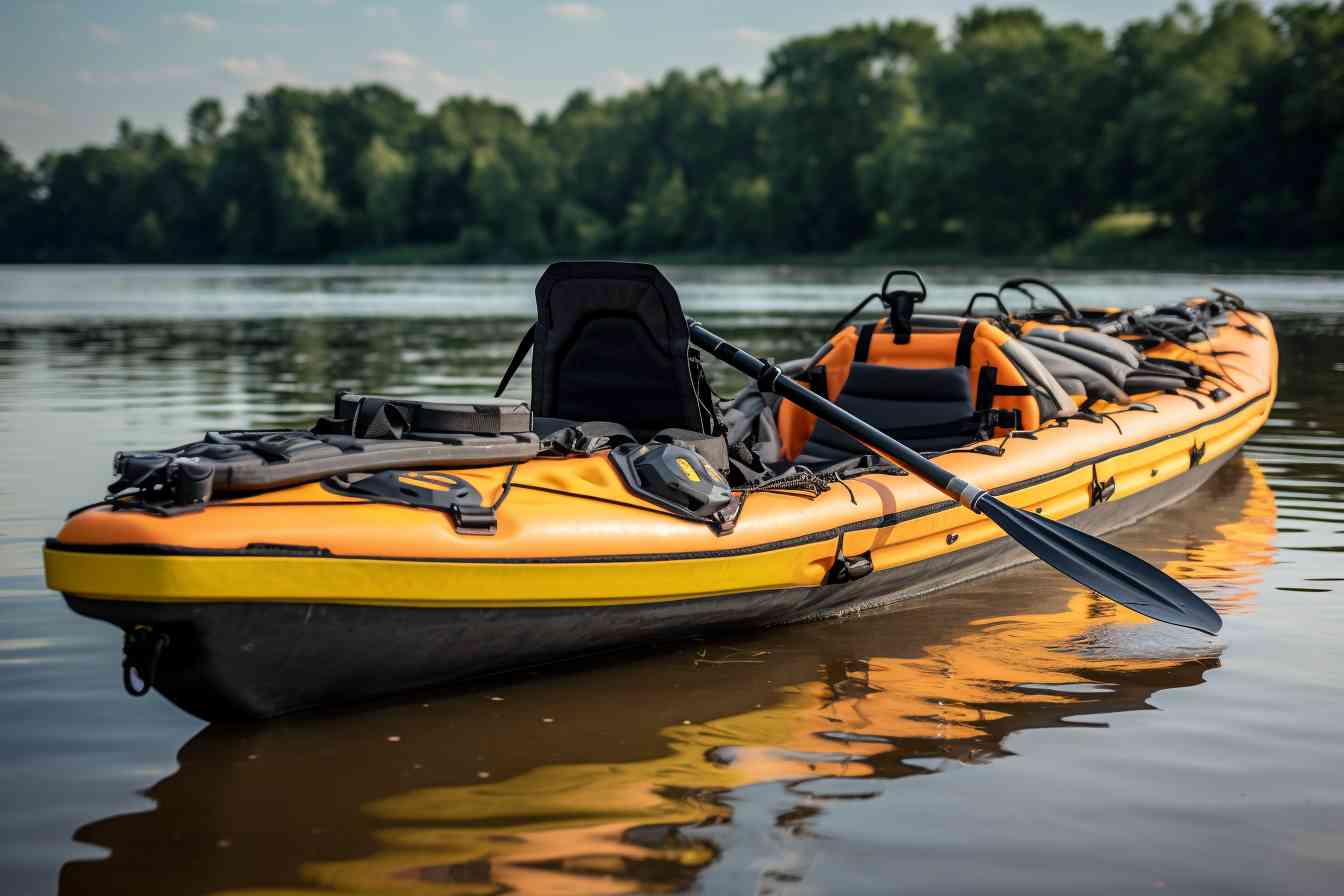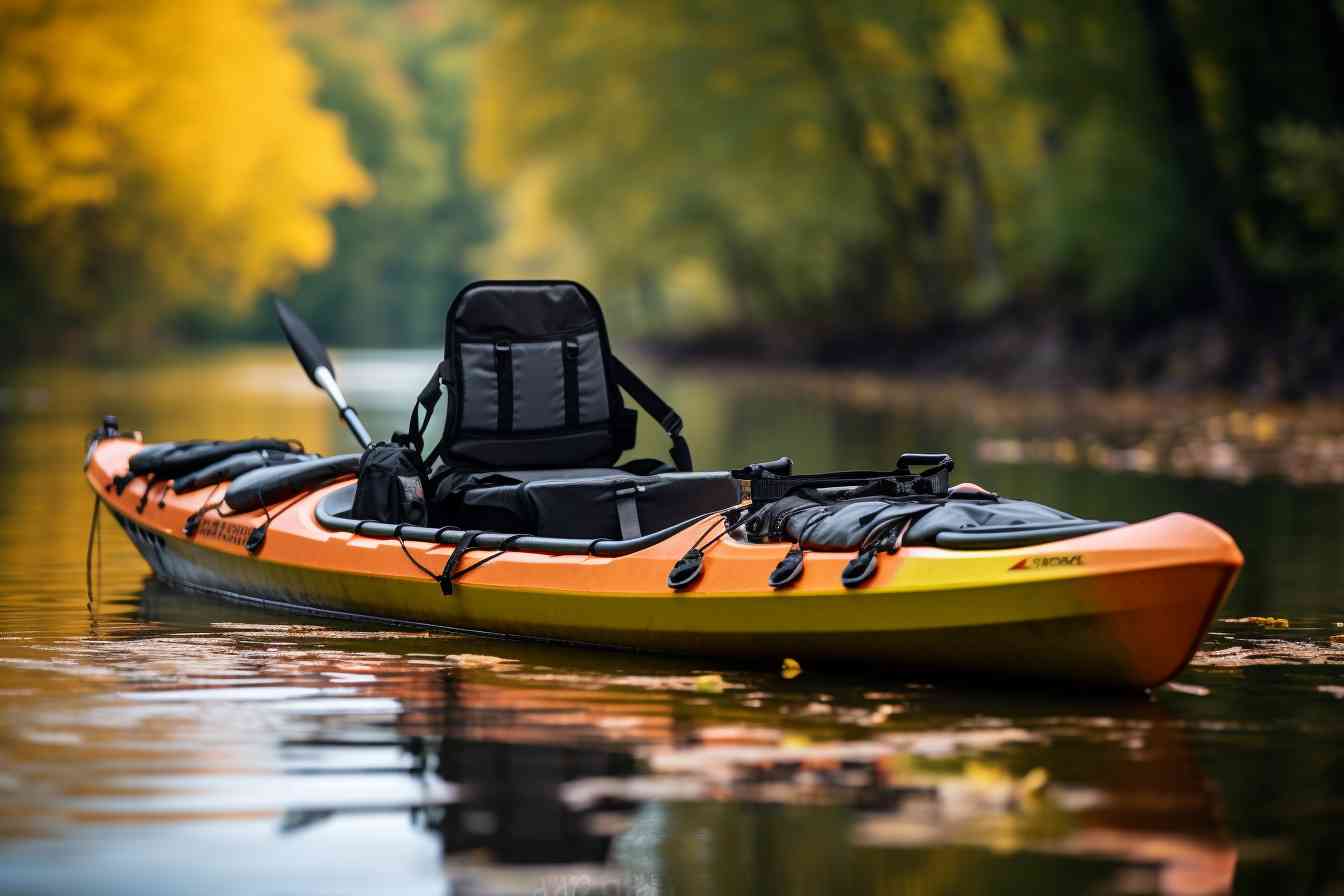Intro: How Much Weight Can A Kayak Hold

Well, ain’t this a question I get all the time! “How much weight can a kayak hold?” A simple question, yet the answer can be quite complex. It’s no surprise that everyone’s curious. After all, kayaking’s become quite the popular pastime these days. We’ve all got our reasons: the peaceful tranquility of the water, the possibility of adventure, or the sheer, unadulterated fun.
But I digress. Remember, it’s not as simple as giving a number. Oh, and don’t you ever make the mistake of assuming that all kayaks are the same. They’re not. Different models and sizes of kayaks have different weight limits. Some can hold as little as 200 lbs. while other beasts can carry up to 500 lbs.
It all really depends on factors like the style and construction of the kayak, the material it’s made of, its length and width, and so on. Let’s not forget about water conditions and the paddler’s skills. Yep, you heard me. Your skills as a paddler can impact how much your kayak can safely hold.
I wish I could just say, “a kayak can hold X amount of weight,” but life ain’t that simple. What I can say is this: always, always check the manufacturer’s guidelines for your specific kayak. It’s crucial to respect those limits for your safety!
Is It Ok To Go Over Weight Limit On Kayak?

Well, let’s dive right into it then, shall we? Now, I’m sure it’s crossed your mind, “Is it OK to go over the weight limit on a kayak?” Well, I’d say, it’s not really advisable, my friend. Pushing those limits could lead us down a hazardous path—jokingly, I’d say, it’s like overfilling a milkshake—you’re just asking for a mess!
There’s a pretty good reason why manufacturers provide us with weight limits for kayaks. When you load up more than recommended, it tends to change how the kayak behaves in water. You might find the kayak feels increasingly unstable, making it easier for you to topple over and risk taking an unplanned dip!
Performance could take a serious hit as well. Overloading can make kayaking more strenuous since the kayak sits lower in the water and has more drag. It may also make it quite difficult for you to control, especially when faced with waves or strong currents.
Then there’s the matter of long-term damage. Continuously exceeding the weight limit might harm the overall structure and integrity of your trusty kayak. And trust me, you wouldn’t want to compromise that.
The bottom line? For safety and performance reasons, and to preserve the lifespan of your gear, it’s better to stick to the weight limit given for your specific kayak. A splash of fun never hurt, but let’s not push our luck too far!
Can An Overweight Person Kayak?

Ah, the question of weight in kayaking. Can an overweight person kayak, you ask? Oh, absolutely! You’d be surprised at the durability and balance of modern-day kayaks. Not to be misconstrued, though, this isn’t about labeling or body shaming; instead, it’s about the pleasure of kayaking and safety above everything else.
So, the question we should be asking is not whether or not an “overweight” person can kayak, but rather, how much weight can a kayak hold?
Kayaks come in many different shapes and sizes, and each type has a specific weight limit. Recreational kayaks, for instance, can carry approximately 250 to 300 pounds. Tandem kayaks, as the name suggests, are designed to carry two people and usually hold around 500 to 600 pounds.
No matter your size, there’s likely a kayak that’s perfect fit for you! As a general rule, never exceed the weight limit noted by the manufacturer. Staying within this limit will ensure your safety and the performance of the kayak. More importantly, you must also consider the weight of your gear, in addition to your body weight. Don’t overlook this – it’s crucial for maintaining balance and optimal performance.
Remember, the whole point of kayaking is to enjoy the serenity of the waters, soak in the beauty of nature, and maybe even get a bit of a workout while you’re at it. As long as you choose the right kayak for your weight, there’s no reason why you can’t have a fantastic time on the water!
Can A 300 Pound Person Kayak?

Alright, let’s dive right in with the topic at hand—can a 300-pound person kayak? Absolutely, they can! Kayaking is an activity that’s wonderfully inclusive. It doesn’t matter how hefty or light you are. What does matter, however, is the type of kayak you choose to use.
You see, every kayak is designed with a specific weight limit in mind, usually referred to as its weight capacity. This limit varies depending on the model and type of the kayak. A recreational kayak — easily identified by its wide, stable construction and large cockpit — typically has a weight capacity between 250 to 300 pounds. So, if you’re a heavy-set individual weighing in around 300 pounds, rest assured, there’s likely a kayak out there designed with you in mind.
However, you shouldn’t only consider the kayak’s weight capacity. You also need to bear in mind the gear and supplies you’ll be taking along. The weight of those items adds up quickly, and they eat into the weight capacity that was initially designed for you. So, if you’re planning a kayaking trip and you weight around 300 pounds, look for a kayak with a weight capacity that exceeds your weight by about 50 to 100 pounds. That should give you enough wiggle room for your gear.
In the end, it’s all about balance and even weight distribution. The kayak needs to stay afloat and handle well while you’re out on the water. So, don’t worry too much about your weight. Focus on finding a kayak that fits your body and your needs—you’ll be out paddling in no time!
How Much Weight Can A Kayak Hold Reddit
Boy oh boy, it sure seems like there’s a ton of curiosity out there about just how much weight a kayak can carry! If you’re here due to that burning question, you’re in the right place. We’ve scoured through reddit – that treasure trove of information – and gathered the most interesting tidbits that’ll clear up any confusion because, hey, the internet can be a jungle full of contradictory advice sometimes!
-
Size plays a huge role! Your kayak’s capacity to hold weight dramatically depends on its dimensions. A longer, wider kayak naturally accommodates more weight than a smaller one. But remember, bigger isn’t always better. Larger kayaks can be difficult to maneuver and control, especially for a greenhorn. So, always choose a kayak that suits your skills and the water conditions you intend to tackle.
-
Material matters! Kayaks are constructed from various materials, each with its own strength and durability. Plastic kayaks, for example, are tough and resilient but heavier, while fiberglass kayaks are lighter but more prone to damage. Each material can affect the weight capacity of the kayak, so always check and understand what kind of kayak you have.
-
Don’t push your luck! Some daredevils out there might brag about overloading their kayak without a hiccup on reddit, but that’s one heck of a risky gambit. Most experts suggest staying under the manufacturer’s weight limit beefing of up to 30-35%. Anything beyond – you’re asking for trouble.
-
Kayak’s design affects its weight capacity! Yup, you heard it right. Sit-on-top kayaks usually hold more weight due to their superior buoyancy compared to sit-inside kayaks. Make sure you consider the design of your kayak when calculating its weight limit!
-
Weight distribution is crucial! Don’t just chuck everything inside your kayak haphazardly. Make sure your weight is well distributed throughout the craft. A lopsided load can dangerously tilt or even flip your vessel. Always strive for balance and stability while loading up your gear.
So there you go! We’ve covered some core facts about the weight capacity of kayaks. Remember, when in doubt, always check the manufacturer’s specifications. Stay safe out on the water!
How Do You Calculate The Weight Limit On A Kayak?
It ain’t rocket science, but figuring out the weight limit on your kayak needs some thinking. The manufacturing companies are your first stop. I use this simple trick – it’s looking out for the manufacturer’s weight recommendation. It’s usually listed in the manual or printed on the kayak itself.
But let’s get into the nuts and bolts. You must remember that this limit isn’t just for you! Your gear, food, water – they are all part of the equation. Heck, if you’re planning on catching some fish, consider that weight too! Also, if you’re paddling with a pal, make sure you split the weight evenly.
Are you ready for a little math? Because let’s dive in! Instead of filling your kayak up to its brim, aim for using just 70% of the weight limit. You see, staying under that threshold allows for a smooth ride and insures against capsizes. Let’s say your yak can carry 500 pounds. Doing the math, that’s 350 pounds for you and all your stuff.
And what about the weight above water? The distribution also plays a crucial role. A lopsided load can lead to a flip, faster than you can yell “Help!”
I must caution – exceeding the weight limit is as dangerous as ignoring it. An overloaded boat rides lower in the water, and that my folks, makes it prone to waves and tips. So, play it safe!
Summing up, determining the weight limit of your kayak is more than just a number game. It’s about safety, performance, and – dare I say – survival. So the next time you’re planning to paddle off into the sunset, make sure you’re not sinking your vessel with overburden.
How Much Weight Can A Kayak Hold In Kg
Hey there, fellow kayaking enthusiasts! It’s your ol’ buddy. Now, you’ve probably wondered about this one – just how much weight can our trusty kayak take before it’s in some serious trouble? Let’s dive right into it.
-
First things first – there is no straight answer. The weight capacity varies depending on the specific make and model of your kayak. So, it’s always smart to check out the manufacturer’s specifications. Like’ve told ya before, always read the fine print!
-
The type of kayak you’ve got also plays a role in its weight capacity. For instance, recreational kayaks can typically hold about 113.4-181.4 kgs, while touring kayaks can usually carry around 136-181.4 kgs. That’s quite a difference there, right?
-
But don’t you forget about the magic 30% rule I’ve been harping about. This rule suggests that you shouldn’t load your kayak with more than 70% of its maximum capacity for optimal safety and performance. Trust me, you don’t wanna mess with this one.
-
It’s also worth mentioning that the size of the kayak also affects its weight capacity. The larger the kayak is – the more weight it can hold. So, if you’re a big guy or planning to carry heavy camping gear, you might want to consider a larger kayak.
-
Let’s not forget about the type of materials the kayak is made of. Some kayaks are feather-light and made from super-strong plastic, while others are made from more traditional, heavier materials. The material can indeed affect how much weight the kayak can carry.
-
And of course, the distribution of weight within the kayak is crucial to its balance and stability. An unevenly loaded kayak can tip over more easily and have poor handling. Believe me, I’ve been there and it’s not a fun experience.
-
Lastly, it’s important to remember that the weight rating includes all gear and supplies in addition to the weight of the paddler. So if you weigh 90 kgs and you’re planning on bringing 30 kgs of gear, you’d need a kayak with a minimum weight capacity of 120 kgs. Simple math, but so important!
Just remember, every kayak has its limits. Stay safe and enjoy the paddling experience!
Final Verdict
Well, there you have it. Drum roll, please! The final verdict on how much weight a kayak can hold is… it varies! Just as every person is unique, every kayak differs too. So there isn’t really a one-size-fits-all answer here. Isn’t life full of exciting variables?
Nonetheless, most standard kayaks hold anywhere between 250 and 300 pounds. But as I mentioned earlier, it’s not a strict rule. You can find kayaks that can carry heavier weights, around 500-600 pounds if you look. These are typically tandem or fishing kayaks, designed to accommodate higher loads.
Hold your horses, though! Don’t get too caught up on maximum weight capacity. It’s important, but you also need to consider how the kayak performs when carrying near or at its limit. You don’t want it to become unstable or, heaven forbid, capsize! So, aim for a weight much less than the kayak’s maximum limit.
And let’s not forget, the weight capacity includes not just your weight, but gear, equipment, and any furry friends you decide to take with you. If you’re planning an all-day trip with supplies or even just a fishing afternoon, you need to account for it all.
So, the final answer? Well, you’ve got to do a little legwork and research based on your own weight, your needs, and the type of kayaking you plan to do. But hey, isn’t finding the perfect fit part of the adventure?
Oh, and remember: safety first, folks. Never exceed your kayak’s weight limit. This is not a rule you want to test out.
Frequently Asked Questions
Q1: How Much Weight Can A Kayak Hold Typically?
Wow, right off the bat with a great question! Typically, the weight capacity for a kayak ranges from 250 to 500 pounds. However, this varies based on the type and design of the kayak. It’s best to check the manufacturer’s specifications before hopping in!
Q2: Do Different Types of Kayaks Have Different Weight Capacities?
Absolutely! For instance, tandem kayaks designed for two paddlers generally hold more weight, while compact or inflatable kayaks may have a lower weight limit. And, of course, solid, single-person sea kayaks can usually hold a fair bit of weight too.
Q3: Is There A Way To Increase A Kayak’s Weight Capacity?
Oh, if only! Unfortunately, the weight limit is set by the kayak’s design and material, and trying to increase that may risk your safety. It’s always best to stick within the weight limits provided by the manufacturer. Safety first!
Q4: Can A Kayak’s Weight Limit Impact Its Performance?
Indeed, it can! When a kayak is too loaded, it’ll sit lower in the water, making it less stable and more difficult to maneuver. That’s a no-no for any paddler!
Q5: Can I Include My Gear’s Weight Into The Kayak’s Weight Limit?
Definitely! The weight limit of a kayak includes everything in it: you, your gear, your snacks, your pet hamster. Everything! So always account for all these when checking your kayak’s weight capacity.
Q6: Is It Safe To Kayak If I’m Near The Weight Limit?
Hmm, it’s a bit risky. It’s always a good idea to aim for about 70-75% of your kayak’s weight limit to account for weight shifts while you’re paddling. Going close to the limit might affect your kayak’s balance and performance.
Q7: What Happens If I Exceed The Kayak’s Weight Limit?
Yikes! If you exceed the weight limit, your kayak may become unstable, difficult to steer, or worse, it could capsize. So, keep your load well within the limit!
Q8: Does A Paddler’s Weight Matter More Than Their Gear’s Weight?
Well, both matter! But if you’re a heavier paddler, you may want to consider getting a kayak with a higher weight limit to ensure it can comfortably and safely support your weight.
Q9: How Can I Find Out My Kayak’s Weight Limit?
Good one! Every kayak should have its maximum weight capacity stated in its user manual, website description, or sometimes it’s even molded onto the vessel itself.
Q10: Can I Kayak If My Weight is Below The Kayak’s Weight Limit?
Absolutely! Kayaks are designed to be stable for a range of weights, as long as you’re not exceeding the weight limit, you should be fine and ready for a fun day on the water!

